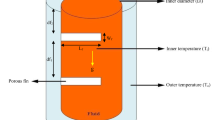Abstract
The absorption characteristics of water vapor into a LiBr-H2O solution flowing down on finned inclined surfaces are numerically investigated in order to study the absorbing performances of different surface shapes of finned tubes as an absorber element. A three-dimensional numerical model is developed. The momentum, energy, and diffusion equations are solved simultaneously using a finite difference method. In order to obtain the temperature and concentration distributions, the Runge-Kutta and the Successive over relaxation methods are used. The flat, circular, elliptic, and parabolic shapes of the tube surfaces are considered in order to find the optimal surface shapes for absorption. In addition, the effects of the fin intervals and Reynolds numbers are studied. The results show that the absorption mainly happens near the fin tip due to the temperature and concentration gradient, and the absorbing performance of the parabolic surface is better than those of the other surfaces.
Similar content being viewed by others
Abbreviations
- A:
-
Flow cross-sectional area of LiBr-H2O solution [m2]
- a:
-
Half of fin interval [m]
- C:
-
LiBr concentration
- Cp :
-
Specific heat of LiBr-H2O solution [J/kg ·K]
- D:
-
Diffusion coefficient ofH 2 O [m 2/s]
- Dh :
-
Hydraulic diameter [m]
- h:
-
Heat of absorption [j/kg]
- l:
-
Flow length of z direction [m]
- n”:
-
Average mass flux of the absorbed water vapor at the interface per unit surface area projected on the x-z plane [kg/m 2 s]
- ΔP:
-
Pressure difference between two fluids on the wall [N/m2]
- Pr:
-
Prandtl number, v/a
- q”:
-
Heat flux accompanied with the phase change [j/m2s]
- q”w :
-
Average heat flux at the wall per unit surface area projected on the x-z plane [j/m 2 s]
- R:
-
Radius of curvature of interface (free surface) [m]
- Re:
-
Reynolds number,\(\bar w\)Dh/v
- Sc:
-
Schmidt number, v/D
- T:
-
Temperature [°C]
- t:
-
Effective thickness of LiBr-H2O [m]
- u, v, w:
-
Velocities of the x, y, and z components [m/s]
- a:
-
Thermal diffusivity of solution [m 2/s]
- Г:
-
Mass flow of solution [kg/s]
- v:
-
Kinematic viscosity of solution [m/s]
- φ:
-
Inclined angle [°]
- θ:
-
Contact angle [°]
- ρ:
-
Density of solution [kg/m2]
- γ:
-
Coefficient of surface tension [N/m]
- e:
-
Interfacial
- b:
-
Cross-sectional
- w:
-
Wall
References
Grossman, G., 1983, “Simultaneous heat and mass transfer in film absorption under laminar flow,”International Journal of Heat and Mass Transfer, 26, 357.
Habib, H. M. and Wood, B. D., 1990, “Simultaneous heat and mass transfer for a falling film absorber,”the Proceedings of the 12th annual ASME International Solar Energy Conference, 61.
Hijikata, K., Lee, S. K. and Nagasaki, T., 1993, “Water vapor absorption enhancement in LiBr/ H2O films falling on horizontal tubes,”Journal of the Japan Society of Mechanical Engineers, 58, 243–248.
Isshiki, N. and Ogawa, K., 1987, “New thermodynamic cycles for utilization of low temperature difference energy sources and new heating surface called CCS,”JSME 25th Power-Energy Utilization Symposium, Tokyo, 63.
Lee, K. S., Seo, S. C., Kim, Y. I. and Park, D. K., 1988, “Coupled heat and mass transfer during the absorption of water vapor into LiBr-H2O liquid solution flowing down the outside of the horizontal cylinder,”Korean Journal of Air-Conditioning and Refrigeration Engineering, 17, 140.
Mcneely, L. A., 1985, “Thermodynamic properties of aqueous solutions of lithium bromide,”ASHRAE Trans, 413.
Uddholm, H. and Setterwall, F., 1988, “Model for dimensioning a falling film absorber in an absorption heat pump,”International Journal of Refrigeration, 11, 41.
Vikas, P. and Parez-Blanco, H., 1996, “A study of absorption enhancement by wavy film flows,”International Journal of Heat and Fluid Flow, 17, 71.
Wasden, F. K. and Dukler, A. E., 1990, “A numerical study of mass transfer in free falling wavy films,”AIChE Journal, 36, 1379.
White, F. M., 1997,Fluid Mechanics, 3rd ed., McGraw Hill international editions, 26.
Yang, Ru. and Wood, Byard. D., 1991, “A numerical solution of the wavy motion on a falling liquid film,”The Canadian Journal of Chemical Engineering, 69, 723.
Yih, S. M. and Seagrave, R. C., 1980, “Mass transfer in laminar falling liquid film with accompanying heat and interfacial shear,”International Journal of Heat and Mass Transfer, 23, 749.
Author information
Authors and Affiliations
Corresponding author
Rights and permissions
About this article
Cite this article
Seo, T., Cho, E. Coupled heat and mass transfer in absorption of water vapor into Libr-H2o solution flowing on finned inclined surfaces. KSME International Journal 18, 1140–1149 (2004). https://doi.org/10.1007/BF02983288
Received:
Revised:
Published:
Issue Date:
DOI: https://doi.org/10.1007/BF02983288




